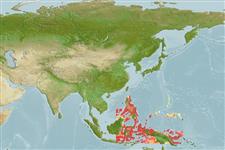>
Gobiiformes (Gobies) >
Gobiidae (Gobies) > Gobiinae
Etymology: Trimma: Greek, trimma, -atos = something crushed (Ref. 45335); trioculatum: Name derived from 'tri' for three and 'oculatus' for having eyes; referring to the extra apparent eye formed by the dark ocellated spot in the first dorsal fin.
Environment: milieu / climate zone / depth range / distribution range
Écologie
marin récifal; profondeur 5 - 71 m (Ref. 102609). Tropical; 20°N - 9°S, 114°E - 154°E
Western Pacific: known with certainty from Indonesia. Non-types collected from Palau, Papua New Guinea and the Philippines.
Taille / Poids / Âge
Maturity: Lm ? range ? - ? cm
Max length : 1.9 cm SL mâle / non sexé; (Ref. 102609); 1.7 cm SL (female)
Description synthétique
Clés d'identification | Morphologie | Morphométrie
Épines dorsales (Total) : 7; Rayons mous dorsaux (Total) : 8 - 9; Épines anales: 1; Rayons mous anaux: 8. This species is distinguished by the following characters: first dorsal fin with a large (slightly greater than pupil diameter in width) round, black, ocellated spot in between spines 1 and 5; a second, much smaller black or dark red spot just posterior to the spine of the second dorsal fin and above the basal stripe; body yellow with a dark purplish or gray head with two distinct red bars across the cheek; without round spots of any colour on the nape, opercle or cheek; upper pectoral fin base with a small dark (preserved) or white (alive) spot; a narrow bony interorbital (<70% pupil diameter); first dorsal fin without elongated spines; pectoral fin rays 15-16, with the middle 4-8 rays branched; fifth pelvic fin ray with a single dichotomous branch; total gill rakers on the first gill arch 16-17 (Ref. 102609).
Inhabits steep outer reef walls, often present in groups of up to 20 individuals which are loosely aggregated and perched vertically on the substrate at the back of small overhangs and crevices. Non-type specimens collected were also nearly always found on steep outer reef walls (Ref. 102609).
Life cycle and mating behavior
Maturité | Reproduction | Frai | Œufs | Fécondité | Larves
Winterbottom, R., M.V. Erdmann and N.K.D. Cahyani, 2015. New species of Trimma (Actinopterygii, Gobiidae) from Indonesia, with comments on head papillae nomenclature. Zootaxa 3973(2):201-226. (Ref. 102609)
Statut dans la liste rouge de l'IUCN (Ref. 130435: Version 2024-2)
Menace pour l'homme
Harmless
Utilisations par l'homme
Pêcheries: sans intérêt
Outils
Articles particuliers
Télécharger en XML
Sources Internet
Estimates based on models
Preferred temperature (Ref.
123201): 28 - 29.1, mean 28.6 °C (based on 68 cells).
Phylogenetic diversity index (Ref.
82804): PD
50 = 0.5000 [Uniqueness, from 0.5 = low to 2.0 = high].
Bayesian length-weight: a=0.00724 (0.00339 - 0.01546), b=3.10 (2.92 - 3.28), in cm total length, based on LWR estimates for this (Sub)family-body shape (Ref.
93245).
Résilience (Ref.
120179): Haut, temps minimum de doublement de population inférieur à 15 mois (Preliminary K or Fecundity.).
Fishing Vulnerability (Ref.
59153): Low vulnerability (10 of 100).
